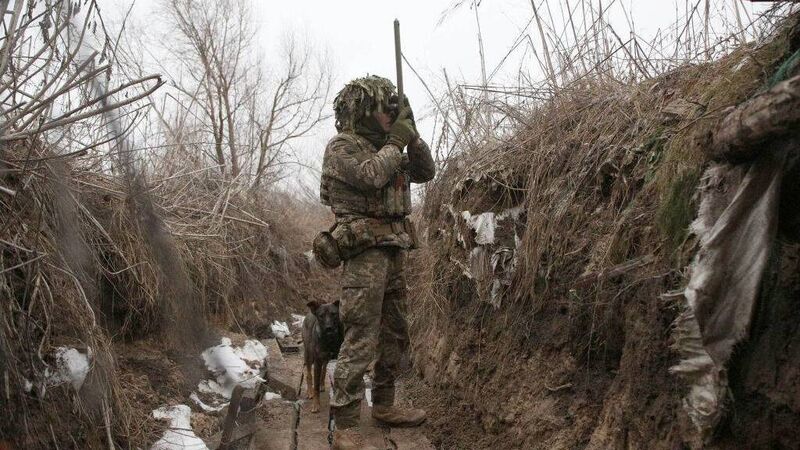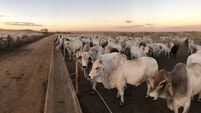Farm Finance: War in Europe's breadbasket - take action to protect your business

A member of the Ukrainian Territorial Defense Forces, the military reserve of the Ukrainian Armes Forces, watches through a spyglass in a trench on the frontline with Russia-backed separatists near Avdiivka, southeastern Ukraine. Photo: Anatolii Stephanov / AFP via Getty Images
The impact of the invasion of Ukraine by Russian forces will result in turmoil, the ripples of which are being felt globally.
Ukraine is Europe’s biggest country apart from Russia, occupying a land area seven times the size of Ireland, at a whopping 603,000 square km. According to the World Bank, 56% of the land base in Ukraine is arable land, compared to just 6.5% in Ireland, 25% in the UK and 33% in France.
The scale of crop production in Ukraine poses the country as a truly massive exporter, with 9.4bn of cereal exported in the year 2020.
Having such a quantity of fertile soils has led to Ukraine gaining the title of being the breadbasket of Europe producing about 12% of global exports of wheat. Ukraine produces around 29.5 million tonnes of maize, exporting around 24 million tonnes.
From an Irish perspective, 27% of maize feed imports originate from Ukraine amounting to a total value of about €73m per annum. Ukraine also supplied 57% of Italy’s maize requirements and 26% of Germany’s maize requirements according to Ibec.
UK figures for 2019 show imports of grain from Ukraine amounted to a total value of £172m, vegetable oils and fats of a further £70m and oilseeds of £35m.
Disruption to the planting season in Ukraine is highly likely. Apart from the conflict itself, it is likely that fuel shortages, damage to infrastructure, displacement of people along with shortages of finance and inability to access finance and supply chain issues will cripple the planting season.
The knock-on effect to an already overheated global cereal market has already sent world prices to record highs - an effect that’s likely to be felt out into the medium term.
UK wheat futures for May delivery moved from £218 per tonne in the first week of February to £231 as of Monday having reached record prices in the middle of last week. As countries such as Ireland, Germany and Italy seek to source grain from other sources the upward pressure on prices will continue.
The shortfall in the production of higher-grade milling wheat could translate into greater price increases for that product with no alternatives available.
Off the back of record EU inflation figures, the prospect of food price hikes and energy price hikes from disruption arising within Ukraine will erode household incomes even further.
From a European perspective, the shocking nature of how events have unfolded is likely to cause a major shift in the policy direction of the EU.
The importance of food security seemed to wain over the past two decades as European policy shifted away from payments linked to production and in the most recent iteration focused on environmental measures.
From an Irish farming perspective, our maize imports from Ukraine can be replaced, but given that cereal prices could escalate higher than existing levels, farmers should, before our own planting season gets underway, consider whether Irish-produced crops such as maize, silage, beet and wholecrop wheat/barley or triticale or home-saved grains could operate as a hedge against significant rises in ration costs for the coming winter.
Given the higher level of silage stocks on farms at this time of year compared to usual, farmers may also wish to strategically aim for higher quality silage at the calculated risk of forfeiting bulk with a view to reducing the amount of supplementation needed.
For farmers whose land isn’t suitable for alternative cropping, consider doing deals with contractors or tillage farmers.
From an energy perspective, the price of coal, gas and oil have also increased over the past week.
Coal reached record prices on Monday last rising more than 20% over the past week Whilst much is made of the gas supplies to Europe, of which Russian accounts for 41% of the supplies, coal and oil are also significant imports for the EU.
According to the EU, for the year 2019 27% of the EU’s import of crude oil came from Russia, whilst 47% of coal imports into the EU came from Russia.
As a hedging strategy, farmers could consider investing or upgrading on-farm generators, along with keeping a reserve of diesel for such purposes in a dedicated bowser, or installing PV with decent battery storage.
For the coming season our grass-based system will stand to us well, how we fare out in the medium term remains very much up in the air.













